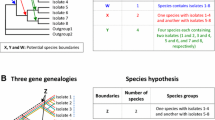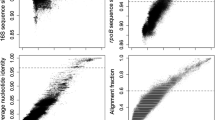Abstract
A key issue troubling bacterial taxonomy and systematics is the lack of a biological species definition. Criteria to be used for defining bacterial species on genetic and biological bases should be able to reveal clear-cut boundaries among clusters of bacteria. To date, DNA–DNA re-association assays and ribosomal RNA sequence comparison have been useful in determining relative evolutionary distances among bacteria but the data are continuous and thus cannot define bacterial clusters as taxonomic units to be called species. Using Salmonella as models, we have looked for definite genetic and biologic uniqueness of clusters of bacteria. Based on our findings that each Salmonella lineage has a unique genome structure shared by strains of the same lineage but not overlapping with strains of other Salmonella lineages, we conclude that this is a result of genetic isolation following divergence of the bacteria. We propose that there should be genetic boundaries between different species of bacteria at the genomic level, which awaits further genomic information for validation.
Similar content being viewed by others
References
Bennett AF, Lenski RE (2007) An experimental test of evolutionary trade-offs during temperature adaptation. Proc Natl Acad Sci USA 104(1):8649–8654. doi:10.1073/pnas.0702117104
Brenner DJ, McWhorter AC, Knutson JK, Steigerwalt AG (1982) Escherichia vulneris: a new species of Enterobacteriaceae associated with human wounds. J Clin Microbiol 15(6):1133–1140
Chen F, Liu WQ, Eisenstark A, Johnston RN, Liu GR, Liu SL (2010a) Multiple genetic switches spontaneously modulating bacterial mutability. BMC Evol Biol 10:277. doi:10.1186/1471-2148-10-277
Chen F, Liu WQ, Liu ZH, Zou QH, Wang Y, Li YG, Zhou J, Eisenstark A, Johnston RN, Liu GR, Yang BF, Liu SL (2010b) mutL as a genetic switch of bacterial mutability: turned on or off through repeat copy number changes. FEMS Microbiol Lett 312(2):126–132. doi:10.1111/j.1574-6968.2010.02107.x
Chiu CH, Tang P, Chu C, Hu S, Bao Q, Yu J, Chou YY, Wang HS, Lee YS (2005) The genome sequence of Salmonella enterica serovar Choleraesuis, a highly invasive and resistant zoonotic pathogen. Nucleic Acids Res 33(5):1690–1698
Cohan FM (2002) What are bacterial species? Annu Rev Microbiol 56:457–487
Cooke FJ, Brown DJ, Fookes M, Pickard D, Ivens A, Wain J, Roberts M, Kingsley RA, Thomson NR, Dougan G (2008) Characterization of the genomes of a diverse collection of Salmonella enterica serovar Typhimurium definitive phage type 104. J Bacteriol 190(24):8155–8162
Crosa JH, Brenner DJ, Ewing WH, Falkow S (1973) Molecular relationships among the Salmonelleae. J Bacteriol 115(1):307–315
DeLong EF, Pace NR (2001) Environmental diversity of bacteria and archaea. Syst Biol 50(4):470–478
Deng W, Liou SR, Plunkett G 3rd, Mayhew GF, Rose DJ, Burland V, Kodoyianni V, Schwartz DC, Blattner FR (2003) Comparative genomics of Salmonella enterica serovar Typhi strains Ty2 and CT18. J Bacteriol 185(7):2330–2337
Doolittle RF, Feng DF, Tsang S, Cho G, Little E (1996) Determining divergence times of the major kingdoms of living organisms with a protein clock. Science 271(5248):470–477
Feng DF, Cho G, Doolittle RF (1997) Determining divergence times with a protein clock: update and reevaluation. Proc Natl Acad Sci USA 94(24):13028–13033
Feng Y, Liu W-Q, Sanderson KE, Liu S-L (2011) Comparison of Salmonella genomes. In: Porwollik S (ed) Salmonella from genome to function. Caister Academic Press, Norfolk, pp 49–67
Fox GE, Stackebrandt E, Hespell RB, Gibson J, Maniloff J, Dyer TA, Wolfe RS, Balch WE, Tanner RS, Magrum LJ, Zablen LB, Blakemore R, Gupta R, Bonen L, Lewis BJ, Stahl DA, Luehrsen KR, Chen KN, Woese CR (1980) The phylogeny of prokaryotes. Science 209(4455):457–463
Gao B, Gupta RS (2012) Microbial Systematics in the post-genomics Era. Antonie van Leeuwenhoek (in press)
Gong J, Liu WQ, Liu GR, Chen F, Li JQ, Xu GM, Wang L, Johnston RN, Eisenstark A, Liu SL (2007) Spontaneous conversion between mutL and 6 bpDeltamutL in Salmonella typhimurium LT7: association with genome diversification and possible roles in bacterial adaptation. Genomics 90(4):542–549. doi:10.1016/j.ygeno.2007.06.009
Holt JG (1984) Bergey’s manual of systematic bacteriology. The Williams & Wilkins, Baltimore
Holt JG, Krieg NR, Sneath PH, Staley JT, Williams ST (1994) Bergey’s manual of determinative bacteriology, 9th edn. The Williams & Wilkins, Baltimore
Holt KE, Parkhill J, Mazzoni CJ, Roumagnac P, Weill FX, Goodhead I, Rance R, Baker S, Maskell DJ, Wain J, Dolecek C, Achtman M, Dougan G (2008) High-throughput sequencing provides insights into genome variation and evolution in Salmonella Typhi. Nat Genet 40(8):987–993
Kauffmann F, Edwards PR (1957) A revised, simplified Kauffmann-White schema. Acta Pathol Microbiol Scand 41(3):242–246
Le Minor L (1988) Typing of Salmonella species. Eur J Clin Microbiol Infect Dis 7(2):214–218
Liu SL, Sanderson KE (1995a) I-CeuI reveals conservation of the genome of independent strains of Salmonella typhimurium. J Bacteriol 177(11):3355–3357
Liu SL, Sanderson KE (1995b) Rearrangements in the genome of the bacterium Salmonella typhi. Proc Natl Acad Sci USA 92(4):1018–1022
Liu SL, Schryvers AB, Sanderson KE, Johnston RN (1999) Bacterial phylogenetic clusters revealed by genome structure. J Bacteriol 181(21):6747–6755
Liu GR, Rahn A, Liu WQ, Sanderson KE, Johnston RN, Liu SL (2002) The evolving genome of Salmonella enterica serovar Pullorum. J Bacteriol 184(10):2626–2633
Liu WQ, Feng Y, Wang Y, Zou QH, Chen F, Guo JT, Peng YH, Jin Y, Li YG, Hu SN, Johnston RN, Liu GR, Liu SL (2009) Salmonella paratyphi C: genetic divergence from Salmonella choleraesuis and pathogenic convergence with Salmonella typhi. PLoS ONE 4(2):e4510
Mayr E (1944) Systematics and the origin of species from the viewpoint of a zoologist. Columbia University Press, New York
Mayr E (1996) What is a species, and what is not? Philos Sci 63:262–277
McClelland M, Sanderson KE, Spieth J, Clifton SW, Latreille P, Courtney L, Porwollik S, Ali J, Dante M, Du F, Hou S, Layman D, Leonard S, Nguyen C, Scott K, Holmes A, Grewal N, Mulvaney E, Ryan E, Sun H, Florea L, Miller W, Stoneking T, Nhan M, Waterston R, Wilson RK (2001) Complete genome sequence of Salmonella enterica serovar Typhimurium LT2. Nature 413(6858):852–856
McClelland M, Sanderson KE, Clifton SW, Latreille P, Porwollik S, Sabo A, Meyer R, Bieri T, Ozersky P, McLellan M, Harkins CR, Wang C, Nguyen C, Berghoff A, Elliott G, Kohlberg S, Strong C, Du F, Carter J, Kremizki C, Layman D, Leonard S, Sun H, Fulton L, Nash W, Miner T, Minx P, Delehaunty K, Fronick C, Magrini V, Nhan M, Warren W, Florea L, Spieth J, Wilson RK (2004) Comparison of genome degradation in Paratyphi A and Typhi, human-restricted serovars of Salmonella enterica that cause typhoid. Nat Genet 36(12):1268–1274
Ochman H, Selander RK (1984) Standard reference strains of Escherichia coli from natural populations. J Bacteriol 157(2):690–693
Ochman H, Wilson AC (1987) Evolution in bacteria: evidence for a universal substitution rate in cellular genomes. J Mol Evol 26(1–2):74–86
Olsen GJ, Larsen N, Woese CR (1991) The ribosomal RNA database project. Nucleic Acids Res 19:2017–2021
Palys T, Nakamura LK, Cohan FM (1997) Discovery and classification of ecological diversity in the bacterial world: the role of DNA sequence data. Int J Syst Bacteriol 47(4):1145–1156
Palys T, Berger E, Mitrica I, Nakamura LK, Cohan FM (2000) Protein-coding genes as molecular markers for ecologically distinct populations: the case of two Bacillus species. Int J Syst Evol Microbiol 50(Pt 3):1021–1028
Parkhill J, Dougan G, James KD, Thomson NR, Pickard D, Wain J, Churcher C, Mungall KL, Bentley SD, Holden MT, Sebaihia M, Baker S, Basham D, Brooks K, Chillingworth T, Connerton P, Cronin A, Davis P, Davies RM, Dowd L, White N, Farrar J, Feltwell T, Hamlin N, Haque A, Hien TT, Holroyd S, Jagels K, Krogh A, Larsen TS, Leather S, Moule S, O’Gaora P, Parry C, Quail M, Rutherford K, Simmonds M, Skelton J, Stevens K, Whitehead S, Barrell BG (2001) Complete genome sequence of a multiple drug resistant Salmonella enterica serovar Typhi CT18. Nature 413(6858):848–852
Parry CM, Hien TT, Dougan G, White NJ, Farrar JJ (2002) Typhoid fever. N Engl J Med 347(22):1770–1782
Popoff MY, Bockemuhl J, Gheesling LL (2004) Supplement 2002 (no. 46) to the Kauffmann–White scheme. Res Microbiol 155(7):568–570
Ravin AW (1960) The origin of bacterial species. Genetic recombination and factors limiting it between bacterial populations. Bacteriol Rev 24(2):201–220
Reeves MW, Evins GM, Heiba AA, Plikaytis BD, Farmer JJ 3rd (1989) Clonal nature of Salmonella typhi and its genetic relatedness to other salmonellae as shown by multilocus enzyme electrophoresis, and proposal of Salmonella bongori comb. nov. J Clin Microbiol 27(2):313–320
Roumagnac P, Weill F-X, Dolecek C, Baker S, Brisse S, Chinh NT, Le TAH, Acosta CJ, Farrar J, Dougan G, Achtman M (2006) Evolutionary history of Salmonella Typhi. Science 314:1301–1304
Schleifer KH, Ludwig W (1989) Phylogenetic relationships of bacteria. In: Fernholm B, Bremer K, Jornvall H (eds) The hierarchy of life. Elsevier Science Publishers BV, Amsterdam, pp 103–117
Sokal RR, Crovello TJ (1970) The biological species concept: a critical evaluation. Am Nat 104:127–153
Souza V, Rocha M, Valera A, Eguiarte LE (1999) Genetic structure of natural populations of Escherichia coli in wild hosts on different continents. Appl Environ Microbiol 65(8):3373–3385
Stackebrandt E, Woese CR (1984) The phylogeny of prokaryotes. Microbiol Sci 1(5):117–122
Staley JT (2006) The bacterial species dilemma and the genomic-phylogenetic species concept. Philos Trans R Soc Lond B 361(1475):1899–1909
Thomson NR, Clayton DJ, Windhorst D, Vernikos G, Davidson S, Churcher C, Quail MA, Stevens M, Jones MA, Watson M, Barron A, Layton A, Pickard D, Kingsley RA, Bignell A, Clark L, Harris B, Ormond D, Abdellah Z, Brooks K, Cherevach I, Chillingworth T, Woodward J, Norberczak H, Lord A, Arrowsmith C, Jagels K, Moule S, Mungall K, Sanders M, Whitehead S, Chabalgoity JA, Maskell D, Humphrey T, Roberts M, Barrow PA, Dougan G, Parkhill J (2008) Comparative genome analysis of Salmonella Enteritidis PT4 and Salmonella gallinarum 287/91 provides insights into evolutionary and host adaptation pathways. Genome Res 18(10):1624–1637
Vandamme P, Pot B, Gillis M, de Vos P, Kersters K, Swings J (1996) Polyphasic taxonomy, a consensus approach to bacterial systematics. Microbiol Rev 60(2):407–438
Vos M (2011) A species concept for bacteria based on adaptive divergence. Trends Microbiol 19(1):1–7. doi:10.1016/j.tim.2010.10.003
Woese CR (1987) Bacterial evolution. Microbiol Rev 51(2):221–271
Woese CR (2000) Interpreting the universal phylogenetic tree. Proc Natl Acad Sci USA 97(15):8392–8396
Woese CR, Kandler O, Wheelis ML (1990) Towards a natural system of organisms: proposal for the domains Archaea, Bacteria, and Eucarya. Proc Natl Acad Sci USA 87(12):4576–4579
Wu KY, Liu GR, Liu WQ, Wang AQ, Zhan S, Sanderson KE, Johnston RN, Liu SL (2005) The genome of Salmonella enterica serovar gallinarum: distinct insertions/deletions and rare rearrangements. J Bacteriol 187(14):4720–4727
Zahrt TC, Mora GC, Maloy S (1994) Inactivation of mismatch repair overcomes the barrier to transduction between Salmonella typhimurium and Salmonella typhi. J Bacteriol 176(5):1527–1529
Zuckerkandl E, Pauling L (1965) Molecules as documents of evolutionary history. J Theor Biol 8(2):357–366
Author information
Authors and Affiliations
Corresponding author
Rights and permissions
About this article
Cite this article
Tang, L., Liu, SL. The 3Cs provide a novel concept of bacterial species: messages from the genome as illustrated by Salmonella . Antonie van Leeuwenhoek 101, 67–72 (2012). https://doi.org/10.1007/s10482-011-9680-0
Received:
Accepted:
Published:
Issue Date:
DOI: https://doi.org/10.1007/s10482-011-9680-0




